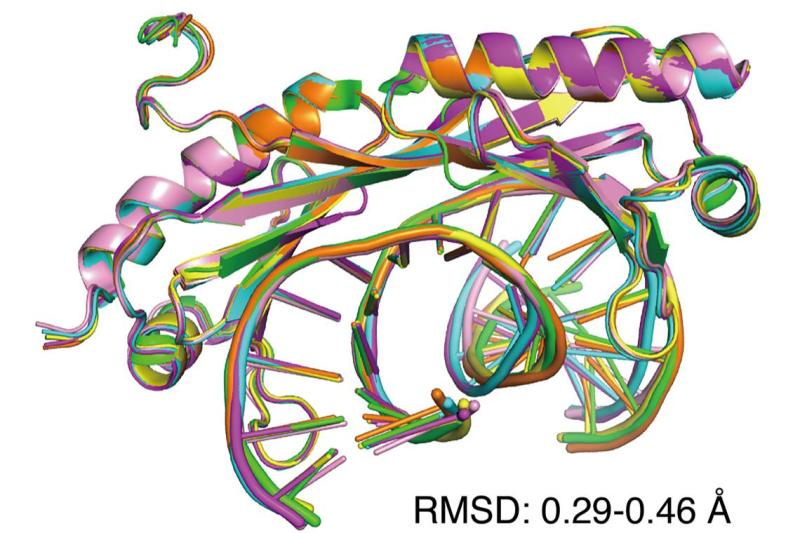
Transcription factor proteins are the light switches of the human genome. By binding to DNA, they help turn genes “on” or “off” and start the important process of copying DNA into an RNA template that acts as a blueprint for a new protein.
By being choosy about which genes they turn on, transcription factors determine which rooms in the house are lighted and which aren’t, or rather, which components of a person’s genome are activated.
A team of Duke researchers has found that transcription factors have a tendency to bind strongly to “mismatched” sections of DNA, sections of the code that were not copied correctly. The strong binding of transcription factors to mismatched sections of regulatory DNA might be a way in which random mutations become a problem that leads to disease, including cancer.
The findings appear Oct. 22 in the journal Nature.
Most of the time, DNA replication in the body goes smoothly, with nucleotides locking arms with their complementary base pair and marching through the cycle together in intended A-T and C-G fashion. However, as Gordan describes it, “no polymerase is perfect” and every now and then, a nucleotide will be paired with the wrong partner, resulting in a mismatch.
Pipetting transcription factor proteins on slides pre-blotted with thousands of DNA molecule samples, a research team led by Duke computational biologist Raluca Gordan Ph.D., showed that the proteins had a stronger bond with the sections of DNA with the mismatched base pairs than with those with perfectly matched base pairs, or “normal” DNA structure.
But what makes these ‘mistakes’ an attractive binding site for transcription factor proteins? For insight, Gordan, an associate professor in the Department of Biostatistics and Bioinformatics and the Department of Computer Science, reached out to Hashim Al-Hashimi, Ph.D., a James B. Duke Professor of Biochemistry, and expert in DNA structure and dynamics who works just across the street.
Al-Hashimi studies nucleic acids (DNA and RNA) and their interactions with proteins and small molecules, with the idea that how these biomolecules look and move is as important for their function as their chemical properties.
Looking at the experimental results, Gordan and Al-Hashimi came to the conclusion that the strong interaction between transcription factor proteins and mismatched DNA has a lot to do with laziness. When a transcription factor protein binds to DNA, it must spend energy distorting the site, for example by bending the DNA to its will. However, mismatched sections of DNA are already distorted, so the transcription factor protein has to do less work.
“That’s when the transcription factor doesn’t need to pay that energetic penalty” to get the job done, Gordan said.
“If we are ever to attain a deep and predictive understanding of how DNA is recognized by proteins in cells, we need to go beyond the conventional description in terms of static structures and move towards describing both DNA and the protein molecules that bind to them in terms of dynamic structures that have different preferences to adopt a wide range of shapes," Al-Hashimi said.
Gordan said that going forward, the team hopes to understand how this interaction relates to disease development. If a mismatched base pair, bound strongly by a transcription factor, makes it through the DNA replication cycle without being repaired by another type of protein—known as a repair enzyme—it can become a mutation, and mutations can lead to genetic diseases like cancer and neurodegeneration.
“We are now convinced that the interactions between transcription factors and mismatches are really strong,” she said. “So the next step is to understand what this means for the cell.”
“We already know that regulatory regions of the genome harbor more cancer mutations than expected by chance. We just do not know why. The strong interactions between transcription factors and DNA mismatches, which could interfere with repair of the mismatches, provide a novel mechanism for the accumulation of mutations in regulatory DNA.”
Six research groups from the United States and Israel contributed to the project, including the Duke research team of Maria Schumacher, Ph.D., Nanaline H. Duke Distinguished Professor of Biochemistry.
Pilot funding was provided by the Duke Center for Genomic and Computational Biology, and the project is now funded through a recently awarded NIH RO1 grant, “The role of transcription and factor proteins in mutagenesis at regulatory sites.”
CITATION: “DNA Mismatches Reveal Widespread Conformational Penalties in Protein-DNA Recognition,” Ariel Afek, Honglue Shi, Atul Rangadurai, Harshit Sahay, Alon Senitzki, Suela Xhani, Mimi Fang, Raul Salinas, Zachery Mielko, Miles A. Pufall, Gregory M.K. Poon, Tali E. Haran, Maria A. Schumacher, Hashim M. Al-Hashimi, Raluca Gordan. Nature, Oct. 22, 2020. DOI: 10.1038/s41586-020-2843-2
This article was first published in Duke Today